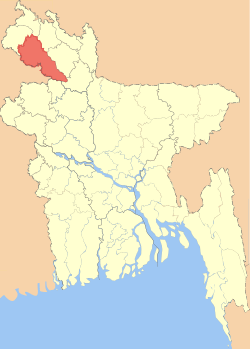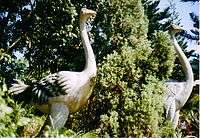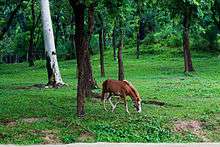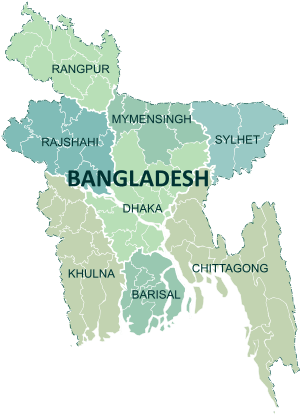Dinajpur District, Bangladesh
| Dinajpur দিনাজপুর | |
|---|---|
| District | |
 Location of Dinajpur in Bangladesh | |
| Coordinates: BD 25°38′N 88°39′E / 25.63°N 88.65°ECoordinates: BD 25°38′N 88°39′E / 25.63°N 88.65°E | |
| Country |
|
| Division | Rangpur Division |
| Government | |
| Area | |
| • Total | 3,444.30 km2 (1,329.85 sq mi) |
| Population (2011 census) | |
| • Total | 2,990,128 |
| • Density | 870/km2 (2,200/sq mi) |
| Literacy rate | |
| • Total | 27.4% |
| Time zone | BST (UTC+6) |
| Website |
www |
Dinajpur (Bengali: দিনাজপুর) is a district in Northern Rangpur, Bangladesh. It is part of the Rangpur Division.
History
Dinajpur was once a part of the ancient state of Pundravardhana. Devkot which rotated as capital of Lakhnauti was located 11 miles south of Dinajpur town. The British administrative control in Dinajpur was established in 1786.[1] At the time of Partition of Bengal in 1947, part of greater Dinajpur district was included in West Bengal and it was named West Dinajpur district. People of the district took part in the Tebhaga Movement and also had significant contribution in the War of Liberation of 1971.[1]
An ancient engraved stone, believed to be from the Gupta era, was recovered from the bank of a pond near Sura Masjid in the Ghoraghat Upazila in Dinajpur in October 8.
Dinajpur Municipality
At first, after its formation in 1856, the Dinajpur Municipality used to be run by a town committee presided over by the Deputy Magistrate. This was among the first 40 municipalities in Bengal at that time. Later in 1868, the 'District Town Act' commissioned a Chairman of the municipality who replaced the Deputy Magistrate and given a similar rank as a District Magistrate. Mr. Patterson was appointed the first Chairman of Dinajpur Municipality in 1869.[2]
Archaeology
.jpg)
Sites of archaeological importance:
- Aowkora Mosque – Meaning, "Echoing Mosque".
- Baraduari
- Dinajpur Museum
- Ghughu-danga Zamindar Bari
- Gour Gabindha
- Habra Zamindar Bari
- Kantajew Temple
- Matasagar
- Nayabad Mosque
- Dinajpur Rajbari
- Ramsagar tank
- Shingha Darwaza – Meaning, "Lion Gate".
- Shita Coat Bihar – The oldest Buddhist Bihar in the world.
- Sitar Kuthuri
- Sukhsagar
- The tombs of Chehel Gazi and Gor-e-Shahid Moydan.
Geography
Dinajpur is bounded by Thakurgaon and Panchagarh districts in the north, Gaibandha and Joypurhat districts in the south, Nilphamari and Rangpur districts in the east, and the state of West Bengal, India in the west. The total area of the district is 3,437.98 km2.[1] The main rivers of the district are the Dhepa, the Punarbhaba, and the Atrai rivers.
Climate
Dinajpur experiences a hot, wet and humid tropical climate. Under the Köppen climate classification, Dinajpur has a tropical wet and dry climate. The district has a distinct monsoonal season, with an annual average temperature of 25 °C (77 °F) and monthly means varying between 18 °C (64 °F) in January and 29 °C (84 °F) in August.
| Climate data for Dinajpur | |||||||||||||
|---|---|---|---|---|---|---|---|---|---|---|---|---|---|
| Month | Jan | Feb | Mar | Apr | May | Jun | Jul | Aug | Sep | Oct | Nov | Dec | Year |
| Average high °C (°F) | 24 (76) |
27 (80) |
31 (87) |
32 (89) |
33 (91) |
31 (88) |
32 (90) |
31 (88) |
31 (87) |
31 (87) |
28 (83) |
25 (77) |
29 (85) |
| Average low °C (°F) | 14 (58) |
17 (63) |
22 (72) |
25 (77) |
26 (79) |
27 (81) |
27 (81) |
27 (81) |
27 (80) |
25 (77) |
21 (69) |
16 (61) |
23 (73) |
| Average precipitation mm (inches) | 8 (0.3) |
20 (0.8) |
58 (2.3) |
117 (4.6) |
267 (10.5) |
358 (14.1) |
399 (15.7) |
318 (12.5) |
257 (10.1) |
163 (6.4) |
30 (1.2) |
5 (0.2) |
1,979 (77.9) |
Economy
The economy of Dinajpur mainly depends upon agriculture based production. Dinajpur is famous for rice production. 'Katharivog' rice is the best produced rice in Bangladesh. Dinajpur is also rich with wheat production. The Lychee(fruit) of Dinajpur is the best of Bangladesh. Dinajpur is also famous for its Mangoes. "Kosba" is called the matrix of mango. Also it grows a plenty of vegetables and seasonal fruits. A huge percentage of people from Dinajpur depends upon agri based products. The main industry also includes rice processing mills. However, Dinajpur is highly rich with natural resources like coal. Of the five coal field discovered so far in Bangladesh, three are in Dinajpur. The name of these deposits are-Barapukuria, Phulbari and Dighipara coal field. At present coal is being produced commercially only from the Barapukuria underground coal mine in Dinajpur district. Current production rate is about 1500 tons per day. The plan to establish an open-pit mine in nearby Phulbari was aborted in 2006 in the wake of a mass protest by the local people.[3] The coal from the Boropukuria Coal Mine is being fed to the 250MW Barapukuria Power Station.
Agriculture

Crops and grown in the district include rice, wheat, maize, potato, brinjal and tomato.
Fruits grown include lychees, mangoes, bananas, jackfruits and blackberries.
Points of interest

- Aowkora Mosque
- Dinajpur Rajbari
- Dipshikha School in Rudrapur
- Gorashohid Boro-Moydan
- Ghughu-danga Zamindar Bari
- Hili Land Port – The second-largest land port of Bangladesh and customs station for border trade.[4]
- Kaliya jue Temple
- Kantajew Temple – A late medieval Hindu temple, built from 1704-1722 CE.
- K. T Complex Proprietor – Raj Kumar Khetan
- Nayabad Mosque
- Nowpara Ideal Village
- Ramsagar
- Shopnopuri artificial amusement park
- Singra forest, Birajgonj.
- Shita Coat Bihar, Nawabganj
- Shimanta Shikha club, Hakimpur, Dinajpur.
- Korai Bill, Biral.
- Ananda Sagar
- Sukhsagar
- Matasagar

Administration
- Deputy Commissioner (DC): Mir Khairul Alam.
- Administrator of Zila Parishad: Azizul Imam Chowdhury[5]
Subdistricts
The upazilas of this district are:
- Biral Upazila,
- Birampur Upazila,
- Birganj Upazila,
- Bochaganj Upazila,
- Chirirbandar Upazila,
- Dinajpur Sadar Upazila,
- Ghoraghat Upazila,
- Hakimpur Upazila,
- Kaharole Upazila,
- Khansama Upazila,
- Nawabganj Upazila,
- Parbatipur Upazila,
- Phulbari Upazila.
Transport

- Railway:
- Roads & Highway:
Education
Hajee Mohammad Danesh Science and Technology University is a government-financed public university of Bangladesh situated 10 km from Dinajpur main town. It serves as an institution of science and technology in northern part of the country.
There are two government colleges in the Dinajpur town. Dinajpur Government College, which was previously known as Surendranath college, is for both male and female students. The other government college is for female students only. Both colleges are operated under Bangladesh National University.
This district gives the opportunity to read in two Govt. schools, Dinajpur Zilla School (for boys only) and Dinajpur Govt. Girls' High School. Dinajpur Zilla School was established in 1854 during the British reign. It is located at the center of the Dinajpur town. It owns a hostel too for residential facilities. This school is one of 20 schools in Bangladesh, which has a govt. funded "E-Learning" facility and E-Laboratory. There is Stone made Map of South Asia subcontinent in this school, which was made at 1934. It has a very talented Score in S.S.C participation. There is also an auditorium, a sculpture of celebrating the 150 years of the school, a mosque, an enhanced library and laboratory in this school. There is also a textile institute.Now RIDGE School is the most modern and British standard popular school of Dinajpur.
Dinajpur Medical College and Hospital
There is a government medical college here, which is one of the 22 government funded medical colleges in Bangladesh. It is located in the town of Dinajpur. It admits 150 students into the f-year MBBS (Bachelor of Medicine and Bachelor of Surgery) degree program. There is a four story building. There are two hostels for boys and three hostels for girls. There are four hostels for intern doctors. Sixteen batches of students have passed from this medical college. Dinajour Medical College Journal is recognized by the BMDC and is published twice a year (ISSN 2070-2019). The 500-bed hospital has high technology and has started to provide more services. There is also a well-developed nursing college behind the hospital building. The hospital has an ultrasound center for nuclear medicine near Sadar Hospital, Dinajpur. Dinajpur Medical College Hospital now provides health services not only in the Dinajpur District but also to people from other districts near Dinajpur.
Other
Dinajpur Central Shahid Minar is the 2nd largest Shahid minar in the country. Dinajpur Boasts a regional training center of Bangladesh Krira Shiksha Pratisthan. Bangladesh Krira Shiksha Pratisthan situated at Basher hat near to HSTU campus. It aims to train and educate sports prodigy. Dinajpur also has a government Veterinary college, a government Polytechnique institute and several private polytechnique institutions. Tenth educational board of Bangladesh has been established in Dinajpur in 2007. From 2009 S.S.C. (Secondary School Certificate) and H.S.C. (Higher Secondary School Certificate) exams have been started to be taken. In S.S.C. exam for the first time it stood 2nd in the country in the G.P.A. 5 list.
Notable residents
- Khaleda Zia – Born in 1945, former Prime Minister of Bangladesh and current leader of the Bangladesh National Party.
- Khurshid Jahan – 1939-2006, former Bangladeshi Minister of Women's and Children's affairs.
- Haji Mohammad Danesh – 1900-1986, Bangladeshi politician and communist activist.
- Subhash Dutta – (9 February 1930 – 16 November 2012) was a Bangladeshi filmmaker, theater and film actor.
- M. Yousuf Ali – Died in 1999, first Bangladeshi Minister of Education.
- Moinuddin Ahmed Chowdhury – 1921-1998, prominent East Pakistani politician.
- Late Prof. Abdullah Al Kafi – (1945 – 2005), Member of Parliament of Jatiyo Sangshad, for Dinajpur-1, distinguished politician and political leader.[6][7][8]
See also
References
| Wikimedia Commons has media related to Dinajpur District. |
- 1 2 3 Ahmad Hossain (2012). "Dinajpur District". In Sirajul Islam and Ahmed A. Jamal. Banglapedia: National Encyclopedia of Bangladesh (Second ed.). Asiatic Society of Bangladesh.
- ↑ Mehrab Ali, "History Of Dinajpur Pourasava" www.dinajpurmunicipality.com
- ↑ Arifur Rahman and Sanzida Murshed (2012). "Coal". Banglapedia: National Encyclopedia of Bangladesh (Second ed.). Asiatic Society of Bangladesh.
- ↑ "Impasse at Hili land port results in loss of Tk20cr". Dhaka Tribune. 22 May 2014. Retrieved 19 February 2015.
- ↑ "AL men appointed administrators". The Daily Star. 16 December 2011. Retrieved 19 February 2015.
- ↑ "Dinajpur-1". Election Commission Bangladesh. Retrieved 12 March 2016.
- ↑ "Obituary reference for Kafi in JS". bdnews24.com. 11 September 2005. Retrieved 12 March 2016.
- ↑ "JS session adjourned without transacting any business following death of Jamaat MP". bdnews24.com. 11 September 2005. Retrieved 12 March 2016.
